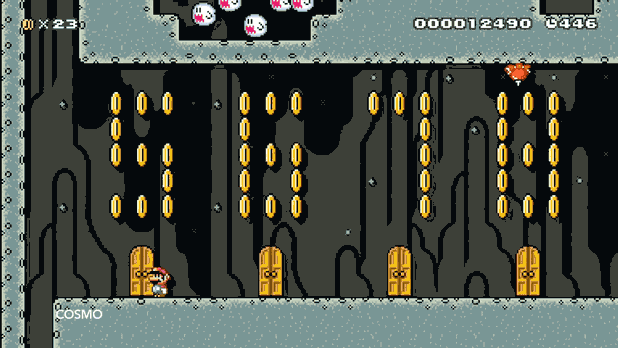With the release of Super Mario Maker, Nintendo wants to encourage fans and players of all ages to try making their own game levels, opening this art to brand-new audiences.
But a good level is about more than placing familiar objects on the screen. To help you get started, we asked 7 professional game designers for their best level design tips. Whether you've never made a level before or you already have some experience making games, their easy-to-understand advice is sure to help you get on the right track.

1. Try structuring your level like a story
Many of the best Mario levels rely on narrative beats for structure. Start by drawing the player in with an inciting incident (a thwomp falling out of nowhere?)—it can include a key mechanic or theme that frames the rest of the level. Then, develop it.
Think of different ways to use the mechanic or theme, and then challenge the player to get better at dealing with it. (Multiple thwomps, thwomps between pits, thwomps on pipes?) Start simple, and only add complexity after the player has proven they understand.
Then, after you've built to the climax, try a third-act twist to cap off the level or turn the idea on its head. Make a joke (Thwomps pestering you all level? Have one fall into a pit!), invert the mechanic (Mario rides on top of the thwomps to the finish!), or try something different to make the last moments memorable.
—Lena Chappelle, game designer/composer, ArenaNet

2. Players should always know where they're supposed to be trying to go
Try using coins or other pickups as "breadcrumbs" to lead the player toward where you want them to go, or to hint at secret detours. Have people play your level often, so you can see exactly where players are likely to get lost or confused.
—Kim McAuliffe, senior designer

3. Use bottleneck moments (door frames, exiting a staircase/elevator, thin hallways, etc) to consider what information you are presenting to the player
These are rare moments where you know exactly where the player will be looking, so use it to your advantage to support the narrative and/or the gameplay objective.
—Beth Beinke-Schwartz, level designer

4. Even if your level is linear, you can never erase the player's feeling of being lost
Give hints and clues about the paths and choices available using things like color, lighting, or positioning in the frame/space. The goal is to make players feel smart because they chose correctly… even if there actually was only one path forward.
—Laralyn McWilliams, senior designer, producer and director

5. Think about relationships between objects, not just the objects themselves
Put some elements near each other, look for a fun interaction, and try to design a way for the player to discover it for themselves.
—Erin Robinson, game designer (Puzzlebots, Gravity Ghost)

6. Your level is probably too hard
You've played it dozens of times and you know the secret to beating it quickly. As you built your level, you might have started getting bored with your puzzles and you tweaked them to make them more interesting to you. By the time you finished designing the level, it's probably gotten too hard for everyone who hasn't already played it 100000000 times.
My old boss used to say, "Reduce difficulty by 30%. And if you think you've already done that, reduce difficulty by another 30%." Some frustration in games is needed, but too much frustration makes people quit. Try starting levels with a win or positive moment for the player—let them take on a few easy enemies, or do a couple satisfying hops that lead to a reward. That way, you earn the player's trust before you start turning up the heat.
—Dana Nelson, Kinda Sweet Studios (formerly Lead Game Designer at Popcap and Lead Level Designer at Playfirst)

7. Build a lot, and then cull your collection
Become a curator for mechanics. Be prepared to trash about 1/3 of your ideas and content. If a puzzle or level doesn't give the player an "aha!" moment, ask yourself why you have kept it.
—Molly Proffitt, Ker-Chunk Games (PrinceNapped)






